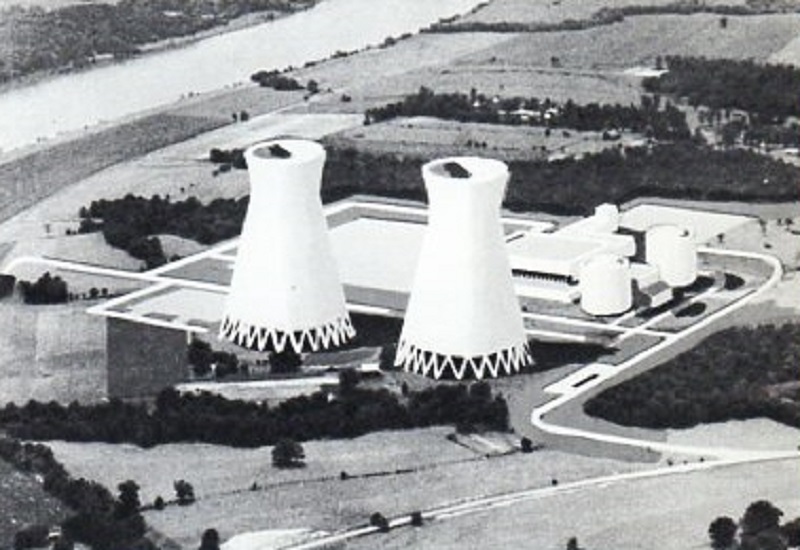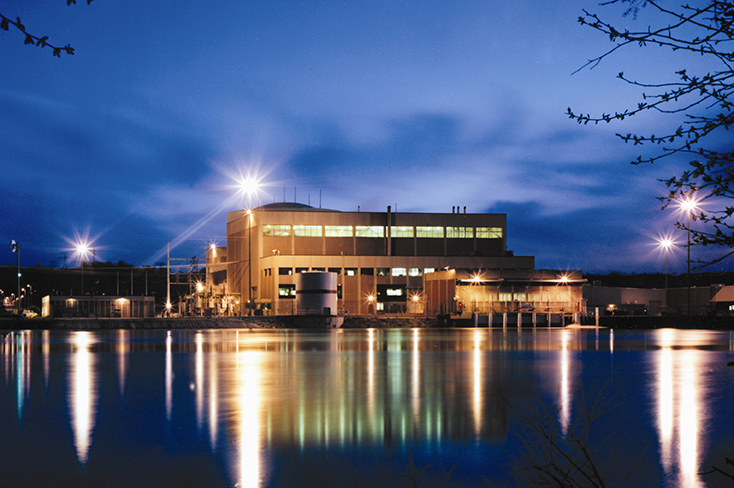Parity
We've seen in the last two weeks both good news and bad for the U.S. nuclear plant fleet, as one nuclear unit under construction came on line and one of the earliest remaining in the U.S. was permanently shut down. The net effect? Raising the total rated megawatts of U.S. nuclear plants slightly, but remaining at the same number of nuclear units on line.

Watts Bar Nuclear Plant concept art, TVA brochure in Will Davis library
Watts Bar Unit 2, part of the Tennessee Valley Authority (TVA) nuclear fleet, finally entered commercial operation on October 19. The project, whose present cost was listed by TVA at $4.7 billion, was completed on schedule -- but that schedule is a new schedule, not the original one.
Watts Bar Unit 2 was ordered all the way back in August 1970 and, at that time, was scheduled for completion in 1976 (Unit 1) and 1977 (Unit 2). The changing fortunes of the time (reduction in estimated power demand, regulatory delay) slowed the build of the units as it did every nuclear unit in the U.S., and the timeline for these units was stretched out. Watts Bar Unit 1 was delayed deliberately by TVA for a long period but finally went on line in 1996. Only in 2012 did TVA make the decision to relaunch work on Unit 2, and at that time estimated it would take $4 to $4.5 billion to complete the unit. Although the cost was slightly higher than that given range, the timeline eventually established was met, and the U.S. added another 1150 MWe of nuclear-generated electricity.
Given that TVA has announced the auction of its Bellefonte site, which is its last remaining legacy unfinished build from the old days, it appears that TVA has definitively written its closure to the construction phase of the First Nuclear Era.

Fort Calhoun Station, courtesy Omaha Public Power District
On October 24 however, less than one week after TVA declared Watts Bar Unit 2 to be in commercial operation, the Omaha Public Power District (OPPD) shut down its venerable Fort Calhoun Station for the last time. The OPPD board had decided in June 2016 that the economic situation with this unit, operating in a region awash in inexpensive natural gas power, was not reversible. The board then made the decision that the best option for its rate payers was to plan shutdown of the unit soon, with the intention that the diminutive (1500 MWt, 478 MWe) be placed in Safe Storage (SAFSTOR) condition for a number of years. This condition allows the radioactivity of certain large plant components, such as the reactor pressure vessel and its internals, to decay considerably before personnel have to gain close access for dismantling -- saving considerably on workers' radiation exposures.
Fort Calhoun had a different history from that of Watts Bar. The plant was ordered in 1966. A second unit also ordered but soon cancelled. The plant had one of the first two commercial Combustion Engineering Nuclear Steam Supply Systems (NSSS) ever ordered - the other being Palisades, in Michigan. Construction and testing took seven years and Fort Calhoun entered service for OPPD in 1973. In later years, operational problems at the plant led to the takeover of operations by Exelon Generation LLC who restarted the plant in 2013 after a prolonged shutdown. Since then, the plant has been a good performer for OPPD, but the simple economics of a small unit in a low-fuel-price market, which industry observers have seen playing out over and over again, simply made the venerable nuclear station impossibly uneconomic to operate.
Surely we have entered the Second Nuclear Era, a term coined by Alvin Weinberg (the fifth president of the American Nuclear Society) to relate to that time in which very much more modern nuclear plants are being built than were designed the first time around. The evidence of this is the Gen-III+ construction ongoing at Plant Vogtle and at V. C. Summer, with perhaps more AP1000 units to come at other sites. The final chapters of the 'build phase' of the First Nuclear Era have arrived, and we see units built in that time already shutting down. Prognosticators would have wished to see a rising number of nuclear units instead of a maintained parity - but economics have cruelly singled out older, smaller nuclear units. Sure, new COL's have been issued that theoretically allow new units to be built but in most cases the owners of the prospective plants have already killed EPC (Engineering, Procurement and Construction) contracts and announced that there are no immediate plans to build the units even if COL's are issued (examples include DTE's Fermi Unit 3, and the Levy County, Florida plant for Duke Power).
For the moment, it appears that status quo is the name of the game.
SEE VIDEO of the final shutdown of Fort Calhoun Station at this link, courtesy OPPD.

